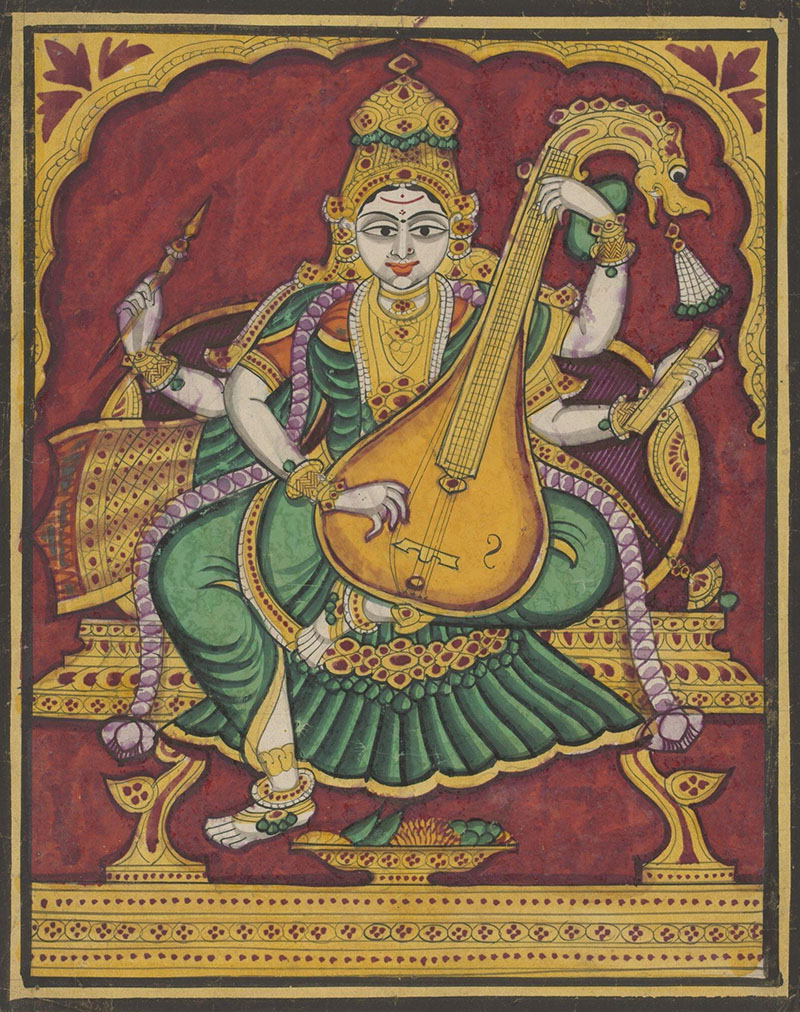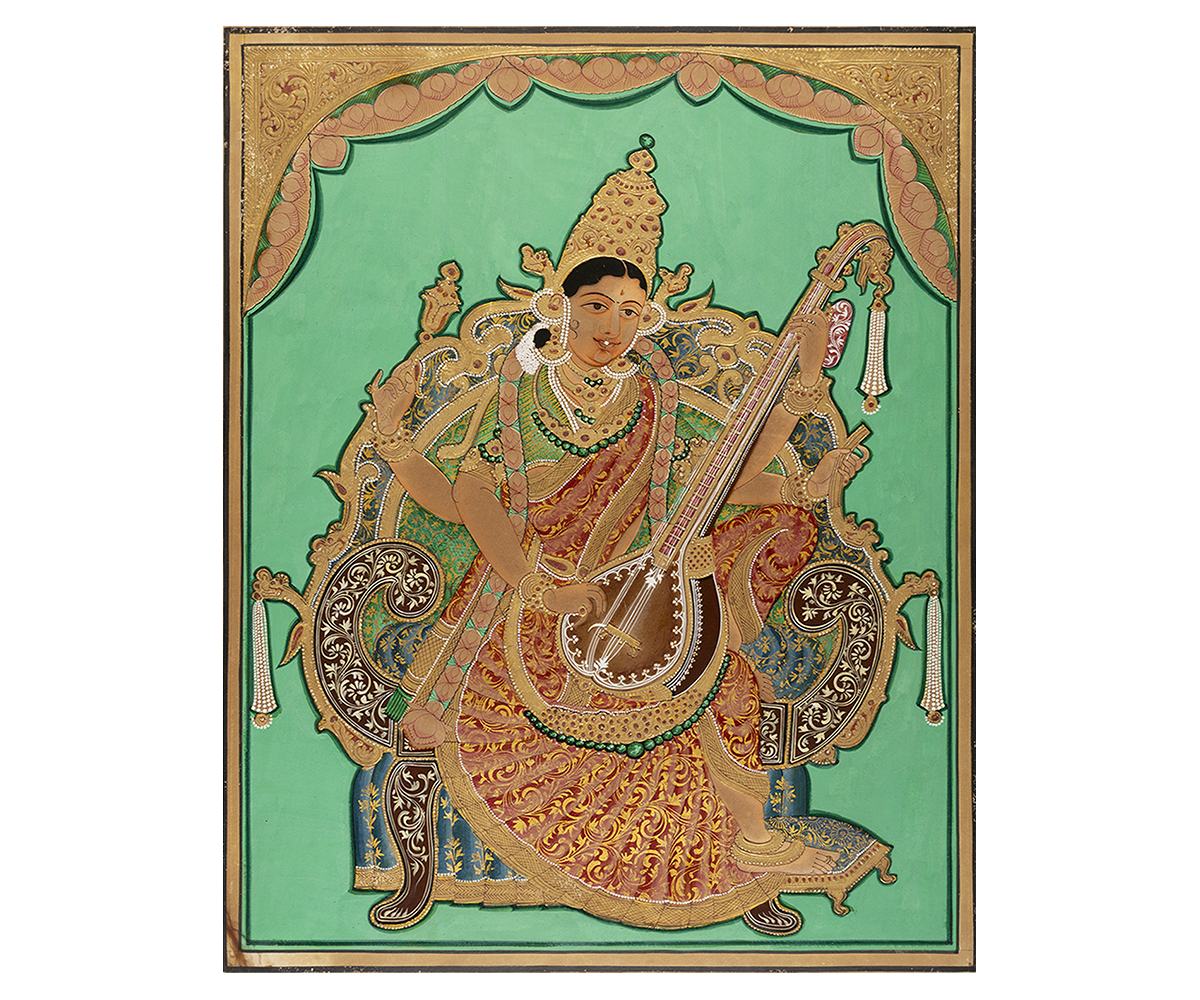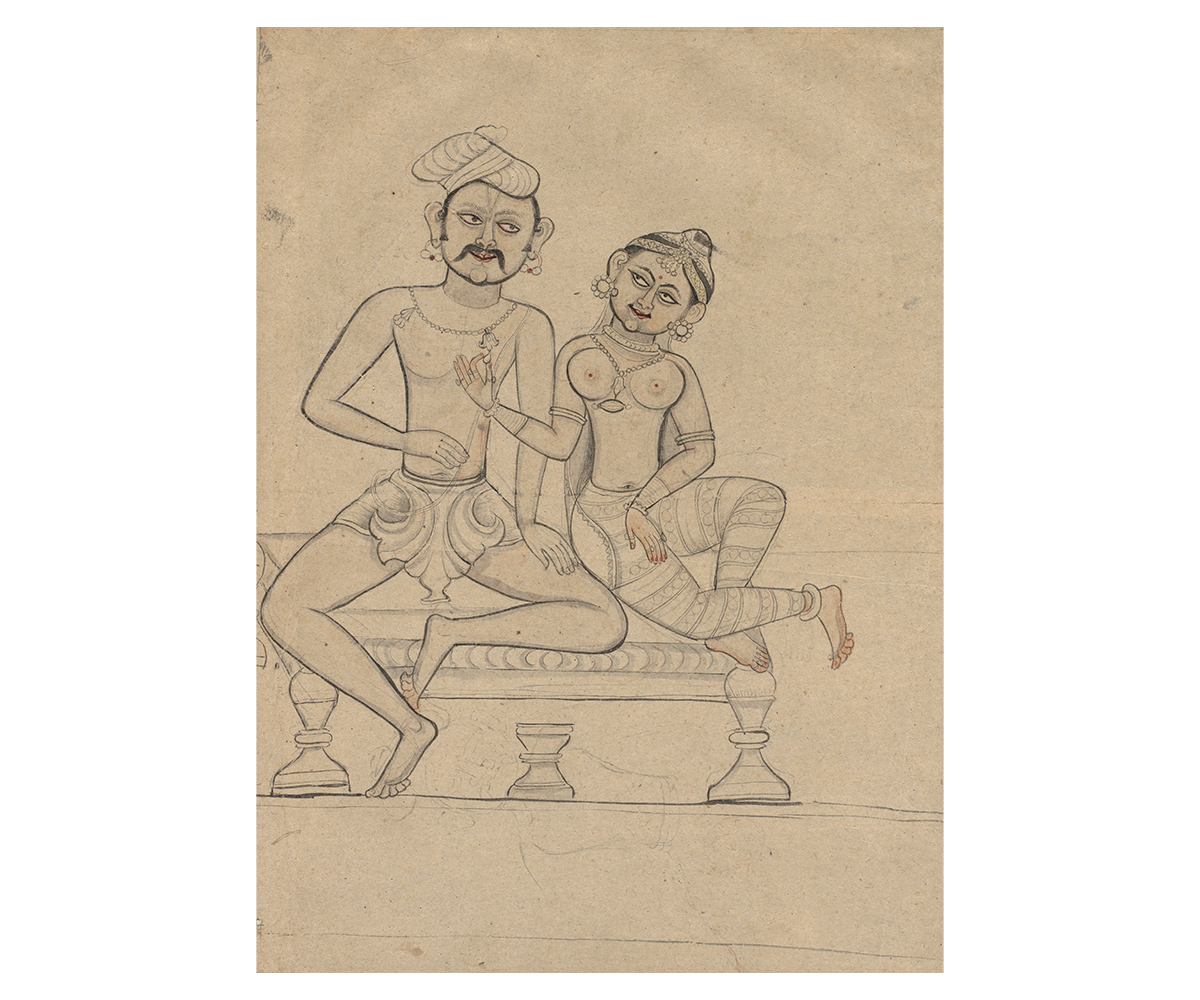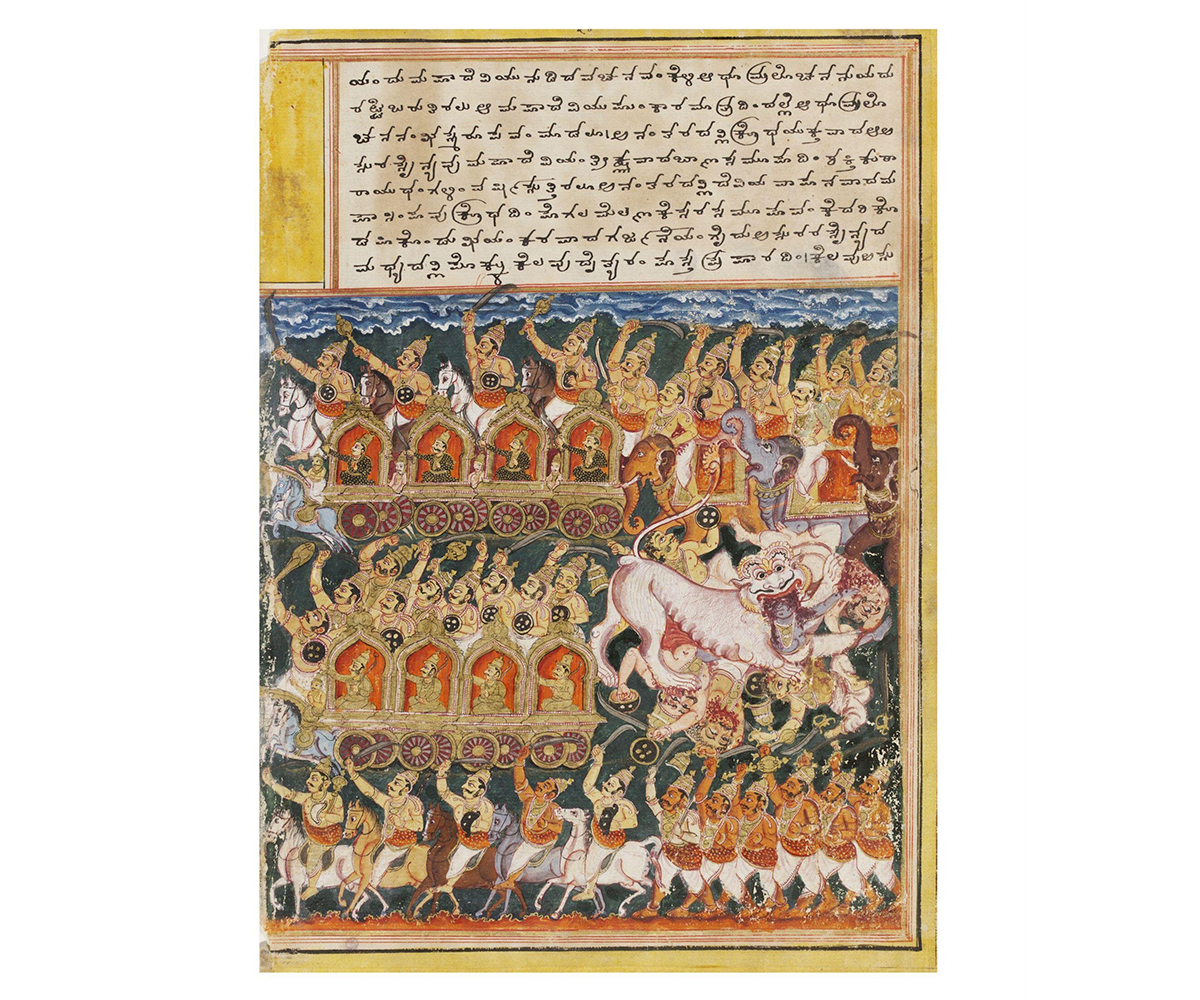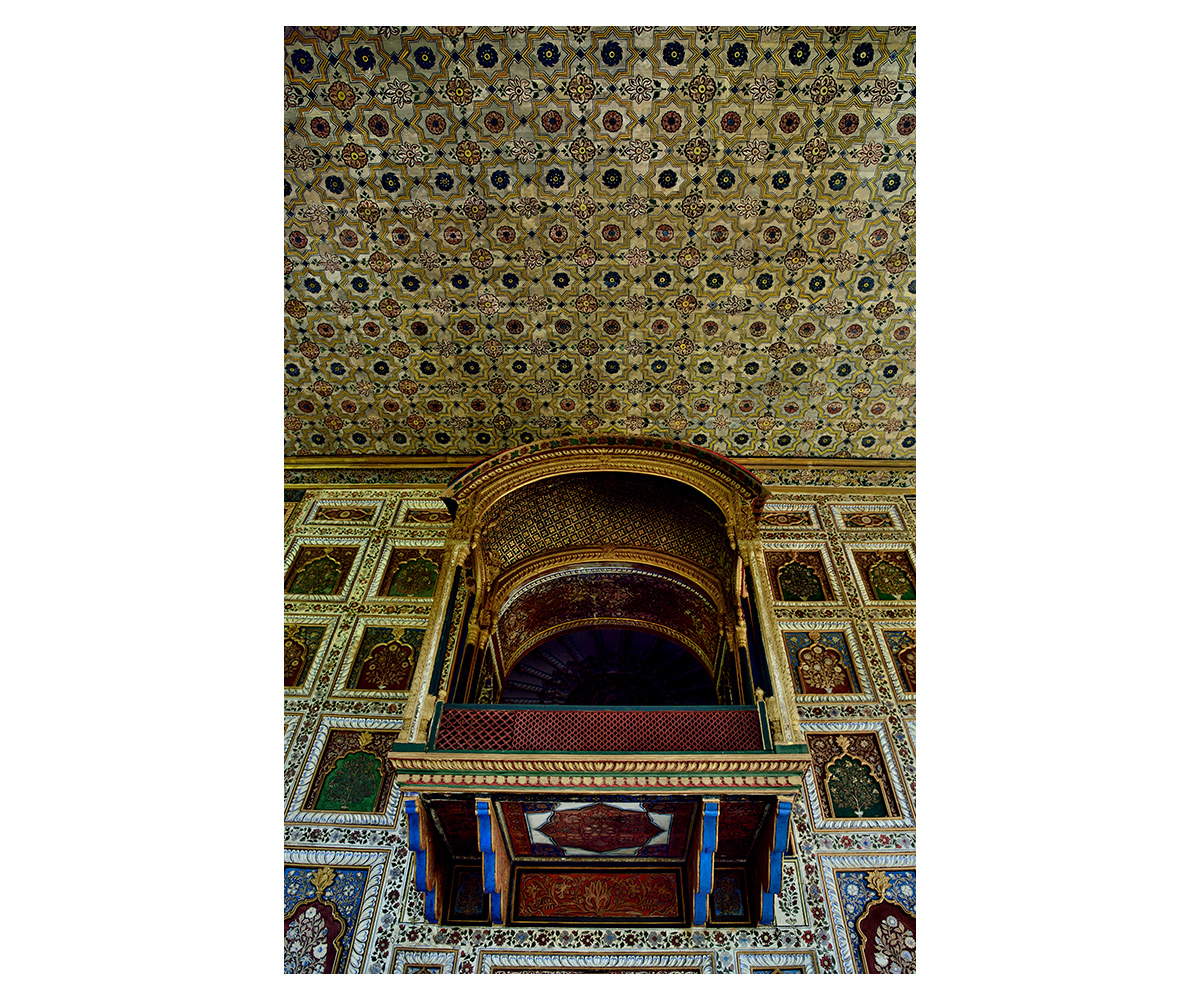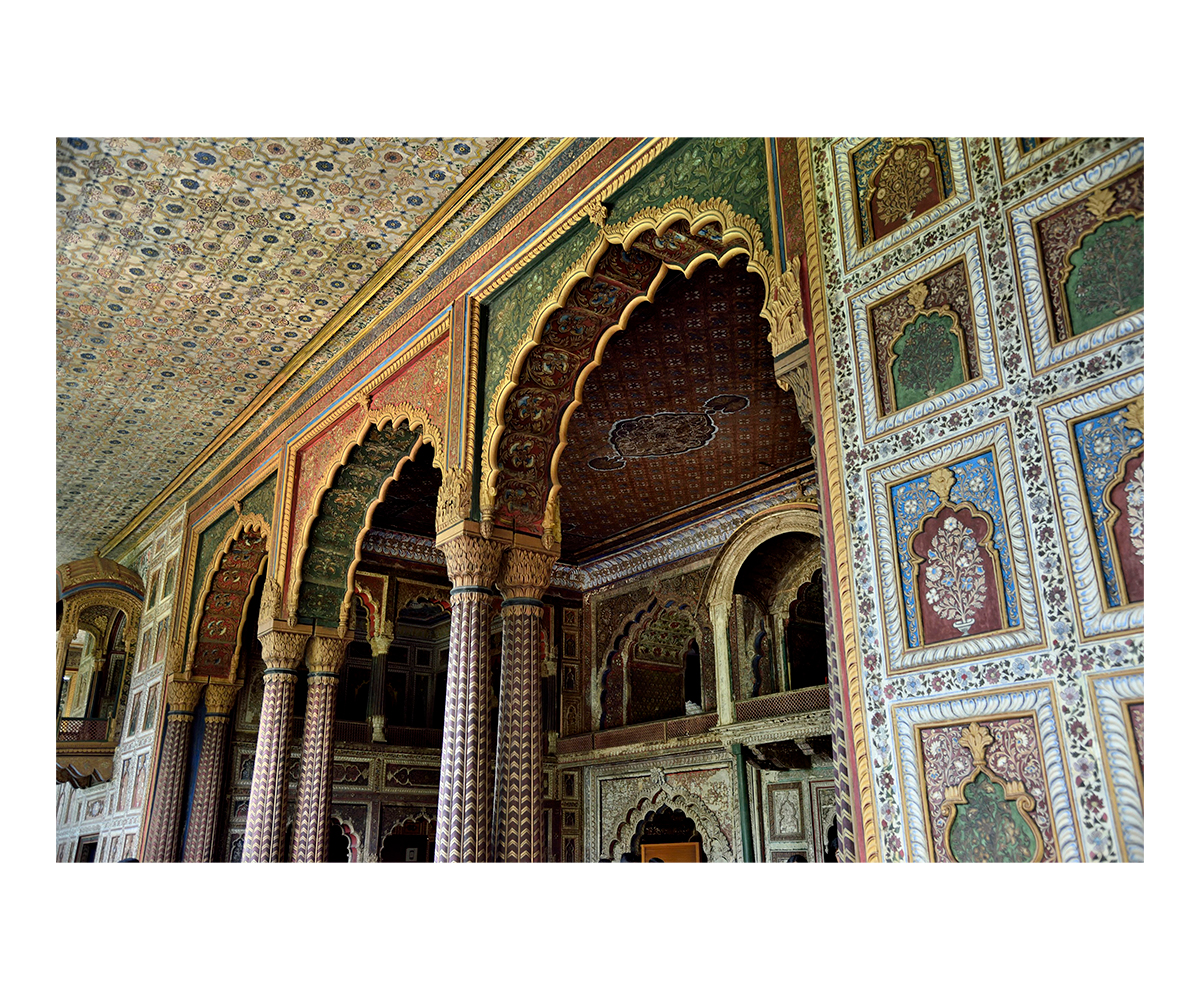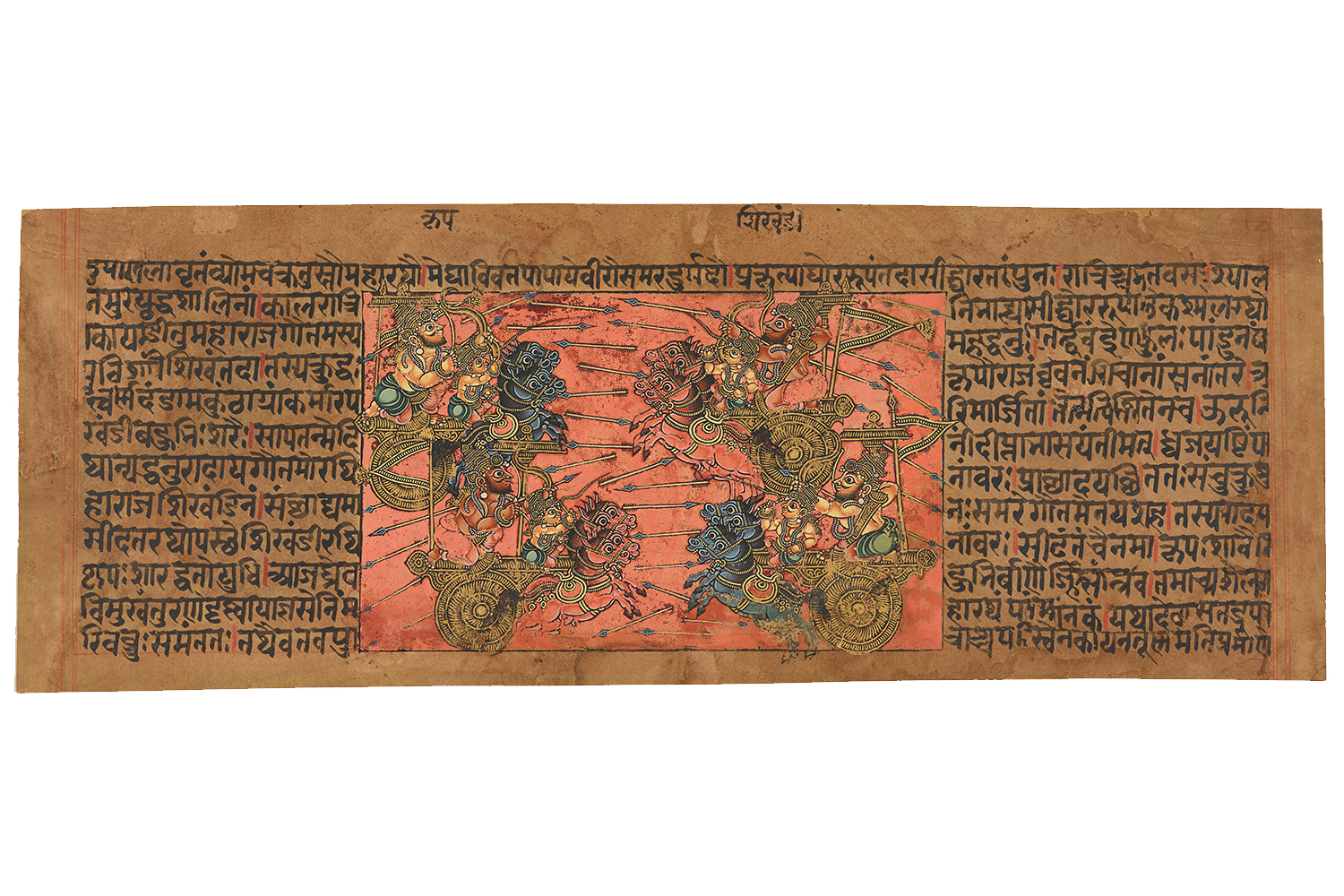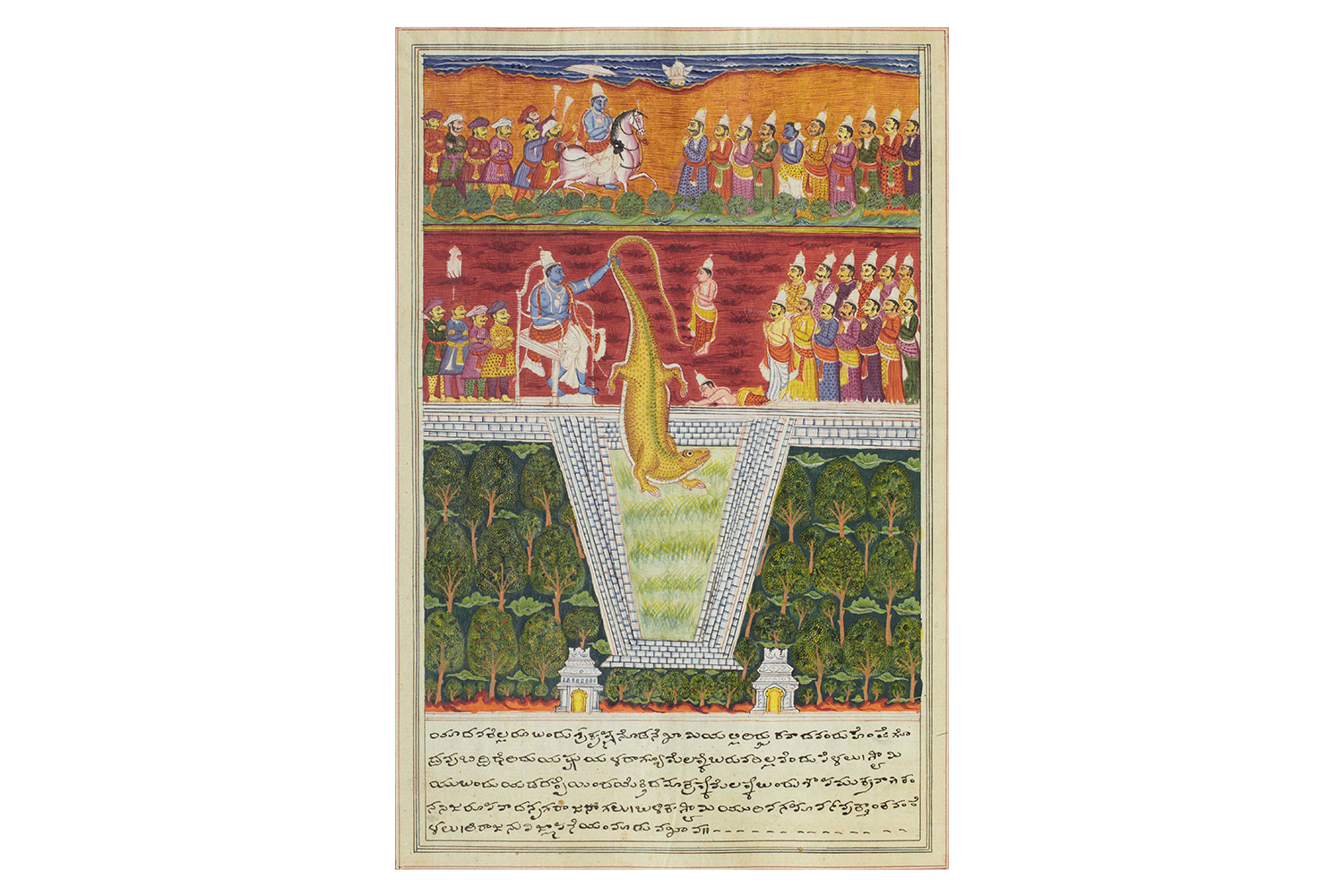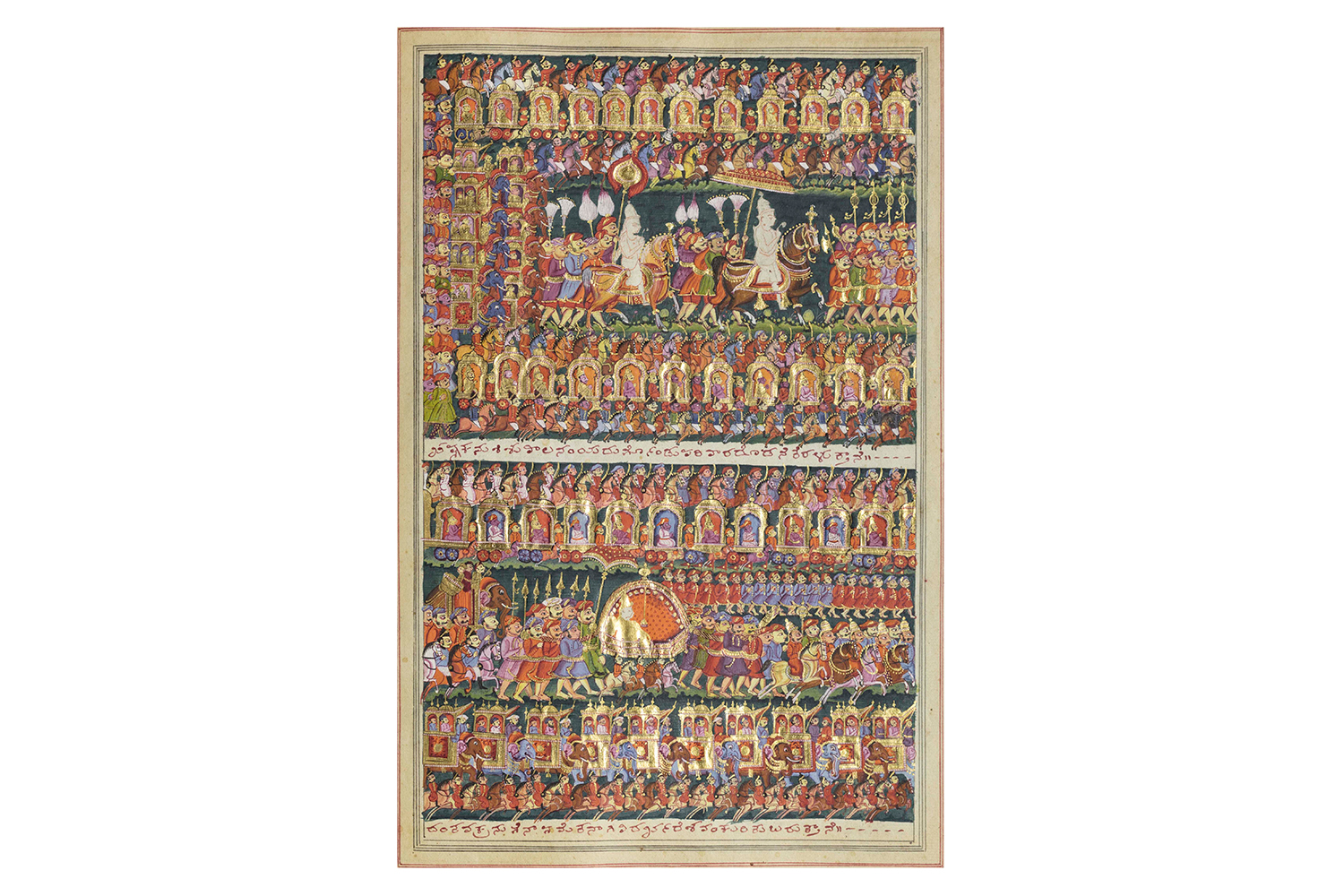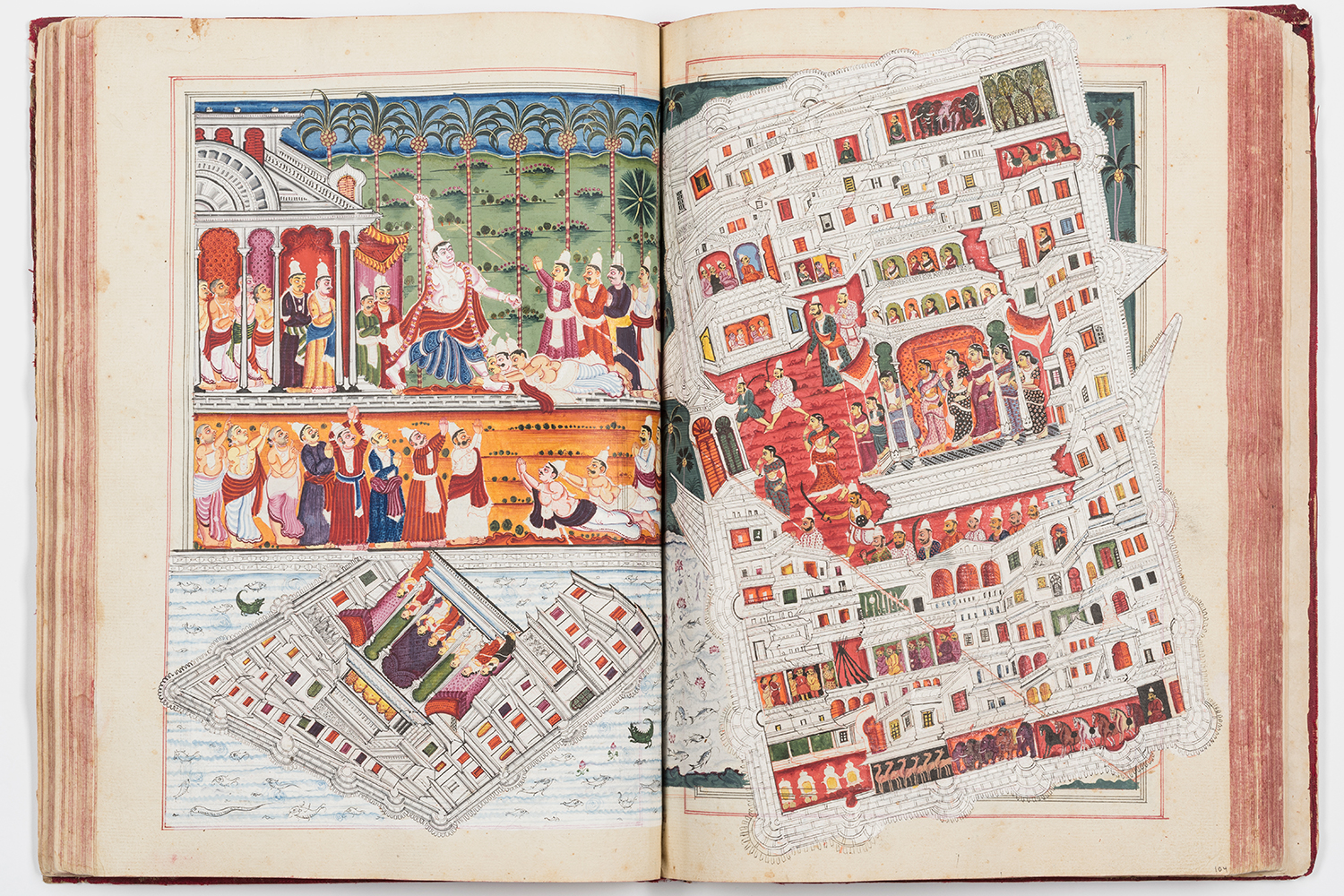ARTICLE
Mysore Painting
The mid-eighteenth century murals at the Shravanabelagola matha, likely commissioned by the monastery itself, depict local courtly life and scenes from a market fair in addition to Jain religious themes such as the life of the Tirthankara Parshvanatha. While their figural compositions and postures follow the Vijayanagara style seen in the murals of Virabhadra Temple in Lepakshi and the Virupaksha Temple in Hampi, the rendering of clothing and the nuances of expressions indicate the emergence of a new idiom.
Similarly, at the Narasimhaswamy Temple, the murals depict a mix of religious and courtly themes. Dated to the late eighteenth and the nineteenth centuries, the murals in different parts of the temple are variously rendered in styles associated with the Vijayanagara, Tanjore and Mysore schools. The walls and ceilings of the main gateway pavilion and the entrance pavilion, for instance, illustrate a number of Hindu religious themes common in the Mysore school. These include depictions of the deity Krishna; scenes from the epic Ramayana; and images from the Bhagavata Purana, the Narasimha Purana and other Puranas,. Alongside these are images of Tipu, Hyder Ali and Krishnaraja III — the last speculated to have been added later. The murals at Dariya Daulat Bagh, which was completed in 1784, depict Tipu Sultan’s court and battle scenes, including the First Battle of Pollilur (1780). Scholars believe that these also may have been painted by artists from different regions, with the possibility of pigments, too, having been imported.
Most extant examples of what is properly considered the Mysore painting style date to the period of Krishnaraja III’s reign in the nineteenth century. As part of his active patronage of the arts, the king commissioned murals at the Prasanna Krishnaswamy, Shweta Varahaswamy and Prasanna Venkataramana Swamy temples, and the Jaganmohan Palace (now Jayachamarajendra Art Gallery) in the city of Mysore.
The subjects of these commissions ranged from religious themes to portraiture and scenes of courtly life. At the Shweta Varahaswamy and Prasanna Krishnaswamy temples — built in 1809 and 1825 respectively — the murals depicted religious scenes from the Bhagavata Purana. At the Prasanna Venkataramana Swamy temple, built in 1836, Krishnaraja III commissioned a chitramandapa (‘painted hall’) above the temple for his personal use. This space was decorated with depictions of Vishnu’s incarnations, as well as an illustrated map based on a pilgrimage that a priest named Subbarayadasa undertook with Krishnaraja III’s sponsorship. It showed temples, monasteries and other holy sites across India in a bird’s eye view, and illustrated the central deity of each in anthropomorphic form.
The murals at the Jaganmohan Palace are situated in the Rangamahal (‘Hall of Colour’) and were executed by court artists led by Tippanna and Sundarayya. In addition to scenes of courtly life such as the annual Dussehra procession, known as Dussehra Jambusavari, hunting scenes and board games, the paintings also include depictions from the mythology of Krishna. One painting depicts Krishnaraja III enjoying the festival of Holi in his harem, employing a convention similar to those of the rasalila dance compositions depicting Krishna. A prominent mural in the Rangamahal features a genealogy of the Wadiyar dynasty in the form of a large lotus with each ruler depicted in a portrait on an individual petal. An image of the moon at the top symbolises the dynasty’s identity as Chandravamsha (‘lunar lineage’) monarchs, and mythological connections are also drawn with Hindu deities through images of Chamundeshvari, Shiva, Vishnu and Brahma.
Krishnaraja III’s commissions of devotional portraits and depictions of himself in idioms closely associated with the deity Krishna are linked by scholars with the traditions of Mughal and Rajput court painting, in which the association of kings with divinity was commonplace. Seen collectively, these commissions are believed to have been aimed at asserting and redefining Krishnaraja III’s kingship following his loss of political power in the affairs of the state.
The production and illustration of manuscripts during Krishnaraja III’s reign — driven by his own contributions as an author and patron — constitute a significant phase of Mysore painting. One of his most recognised works is Shritattvanidhi, a compendium on religious philosophy, literature, music and art, derived from ancient texts on the subjects. Each of its three manuscripts contain around two thousand brightly coloured illustrations. Featuring a monochrome background, many of these are distinctive for their diagram-like treatment. The deities are painted with a strict adherence to traditional iconography, and set the guidelines for depicting religious figures according to the Mysore style. One distinct category of paintings in the text is the representation of musical elements, mirroring the Ragamala genre of North Indian painting. A compendium on dance, the Sarasamgraha Bharata, is similarly illustrated. Another significant illustrated manuscript of the age is a Kannada version of the Devi Mahatmya, also written by Krishnaraja III. Influence of Rajput and Deccani miniature painting styles, especially in depicting foliage, is evident in the illustrations of the Ramayana-Sundarkanda manuscript.
The illustrated manuscript of the Bhagavata Purana, now known as the Mysore Bhagavata, is another prominent work of the period. Only the second half of the Dasama Skandha or the tenth book has been found, and little is known about its patron, painters or date of commissioning. According to scholars, it is likely that Tipanna and Sundarayya, who were among the artists of the Jaganmohan Palace murals, were a part of the Mysore Bhagavata project.
In addition to manuscripts, the court painters also created portraits of Krishnaraja III, which depicted him in formal and informal settings, and in scenes of worship. As in the murals, here too the king was generally portrayed in royal regalia, showing a three-quarters view of his face — an angle previously associated with informality and the portrayal of commoners in South Indian painting, but consistently used for Krishnaraja III to project stability amid political uncertainty. Scholars point to a visual hybrid of traditional, stylised and iconic forms of kingly portraiture in these images; a degree of naturalism is also seen, as in the depiction of ageing through the greying of his moustache.
In addition to manuscript illustrations, Krishnaraja III also commissioned a host of devotional icons, varying widely in size from a few centimetres to several metres across. Made using watercolours from natural pigments and ornamented with gold leaf, these images were circulated as objects of worship among the courtly as well as professional classes, for homes and for public spaces such as bhajan or prayer halls. Such images for worship were also being produced, in a different stylistic idiom, in Tanjore during the eighteenth and nineteenth centuries.
Especially popular among the various Vaishnava and Shaiva deities and themes depicted in these icons was Rajarajeshwari, a form of Parvati. Another common theme was Sri Rama Pattabhisheka, the coronation of the Hindu deity-king Rama. Unlike other Indian painting traditions, where Rama is portrayed in blue or darker hues, he is rendered here in a lighter, yellowish hue. Iconic paintings of Jain Tirthankaras were also made.
The principal deities in these religious paintings are often depicted seated on the kingdom’s renowned seat of power, the Ratna Simhasana (‘Golden Throne’) mythologically associated with the Pandavas in the Mahabharata. The settings emulate the style and furnishings of the palace and contemporary buildings in the city of Mysore.
The creation of these paintings was underpinned by ritual traditions passed down among the artisan community. Mysore paintings were created using watercolours on a variety of surfaces including paper; paperboard; wood; and cloth pasted on wood. The first step was the preparation of the ground. This typically involved the application of a paste of powdered white lead and gum arabic on the surface — with the addition of ganji or rice gruel for cloth (which was pasted onto a wooden board) and yellow ochre pigment for wood. When the application was dry, the surface was burnished to a smooth finish. By the late nineteenth century, thin, wasli-like paper mounted on layers of newspaper, became the primary ground for the paintings.
On the prepared ground, artists traced a rough sketch or a stenciled design onto it with charcoal and red ochre, and proceeded to paint these in. Once major sections of the painting had been coloured, a gesso — made of powdered white lead sometimes with the addition of gamboge, a yellow pigment — was applied around details of jewellery and textiles in low-relief patterns. This gesso work was either embellished with gold leaf or left ungilded, when it was known as makki safeda. This subtle use of gesso with selective gilding is one of the distinguishing features of Mysore painting when compared with the contemporaneous South Indian school of Tanjore painting, which also used gesso and gilding but with high relief and abundant gold-work, with the addition of glass and pearls for embellishment. The completion of a religious painting was marked by netronmilana — the ritual painting of the pupils, symbolising the deity opening their eyes.
The colour palette of Mysore paintings traditionally included reds, greens and yellows derived from plant and mineral sources. The tones were soft rather than highly saturated, and matched that of the gold work. In the second half of the nineteenth century, European paintings, prints and photography influenced courtly painting across the Indian subcontinent, and factory-made pigments replaced plant and mineral-derived colours. By the late nineteenth century, Mysore painting expanded its palette to include synthetic vermilion, ultramarine and emerald green, and crimson. According to scholars this shift may have been prompted by the arrival of the artist Kondayya from the Tanjore court, which had already been exposed to Western painting conventions and was to become an important centre for Company painting in southern India.
Around the same time, the Mysore artists began depicting deities against naturalistically drawn landscapes or architectural settings. In the case of narrative scenes, they began using these elements as scene dividers, breaking away from the earlier convention of formal borders. When used, decorative elements such as border ornamentation and textile patterns, were rendered in fine line work. Oval faces and rounded figures became commonplace. Exposure to the emergent medium of photography led to the introduction of shading as a device to suggest volume and to heighten naturalism in the depiction of textiles too.
The reigns of Krishnaraja III’s successors Chamaraja Wadiyar X (r. 1868–94) and Krishnaraja Wadiyar IV (r. 1902–40) were marked by an even stronger influence of photography and Western art. The shift towards the Western academic style of oil painting is evident in the Wadiyar family portraits commissioned from the Academic Realist painter Raja Ravi Varma in the 1880s. In 1904–5, Ravi Varma undertook a series of mythological paintings for the court, and gradually, the conventions of academic style oil painting, for thematic paintings as well as portraiture, were adopted by other Mysore court artists. The notable painters in the atelier of this period include K Keshavaiah, S Shankarappa, Y Nagaraju and K. Venkatappa, the son of Durgada Krishnappa, who had been a painter in the atelier under Krishnaraja III.
The early twentieth century also saw, however, the advent and spread of chromolithography, which enabled the replication and mass-production of images. This reduced the demand for hand-painted works, particularly religious images, and led to the decline of Mysore painting.
Over the last few decades, traditional Mysore painting has seen a revival, spurred by the interest of collectors in the works of the late nineteenth and early twentieth centuries. Among the changes in material and medium today are the use of poster and acrylic colours and the use of paper affixed to a paperboard as the ground. Governmental bodies, non-governmental organisations and institutions such as the Karnataka Chitrakala Parishad are also supporting the art form through training workshops. In 2005, the tradition of Mysore paintings was awarded a Geographical Indications tag.
Today, contemporary Mysore paintings are made commercially while examples of traditional paintings survive at the Sri Jayachamarajendra Art Gallery and murals in temples across the city of Mysuru.
Bibliography
Appasamy, Jaya. Tanjavur Painting of the Maratha Period. New Jersey: Humanities Press Inc., 1980. https://archive.org/details/tanjavurpainting0000appa/page/n6/mode/1up.
Bhuvaneshwari, S. “Tipu Sultan’s Fading Pictures on Seebi Temple Walls.” The Hindu, December 2, 2017. Accessed July 9, 2024. https://www.thehindu.com/news/national/karnataka/tipu-sultans-fading-pictures-on-seebi-temple-walls/article21251443.ece.
B.R., Mamatha. “Alluring Mural Paintings of Seebi.” The New Indian Express, April 4, 2013. Accessed July 9, 2024. https://www.newindianexpress.com/cities/bengaluru/2013/Apr/04/alluring-mural-paintings-of-seebi-464723.html.
Simmons, Caleb. Devotional Sovereignty: Kingship and Religion in India. New York: Oxford University Press, 2020.
Gopal, Choodamani Nanda. “Post-Vijayanagar Paintings in Karnataka.” Proceedings of the Indian History Congress 49 (1988): 696–700. http://www.jstor.org/stable/44148474.
Goswamy, B. N., Robert John Del Bonta, and Caleb Simmons. The Great Mysore Bhagavata: Complete Study of a Manuscript from the Binney Collection in The San Diego Museum of Art. San Diego: The San Diego Museum of Art; New Delhi: Niyogi Books, 2019.
Intellectual Property India. “Mysore Traditional Paintings.” Geographical Indications Registry. Accessed August 23, 2024. https://search.ipindia.gov.in/GIRPublic/Application/Details/32.
Nair, Janki. Mysore Modern: Rethinking the Region Under Princely Rule. Hyderabad: Orient Blackswan, 2012.
National Folklore Support Centre. “Mysore Painting.” NFSC Public Programme May 2003. https://web.archive.org/web/20031030072752/http://www.indianfolklore.org/pdf/visualart/Mysore.pdf.
Rossi, Barbara. From the Ocean of Painting: India’s Popular Paintings 1589 to the Present. New York: Oxford University Press, 1998. https://archive.org/details/fromoceanofpaint0000ross/page/82/mode/2up.
Sastry, B. V. K. “Traditions in Painting.” Marg 35, no. 1 (December 1981): 63–70.
Singh, R. G. “Mysuru Paintings.” Thanjavur’s Gilded Gods: South Indian Paintings in the Kuldip Singh Collection. Edited by Anna L Dallapiccola, Kuldip Singh, and R. G. Singh. Mumbai: Marg Publications, 2018.
Sivapriyananda. “Note: Mysore School of Traditional Painting.” Marg 41, no. 4 (1990): 68–71.
Welch, Stuart Cary. India: Art and Culture 1300–1900. New York: The Metropolitan Museum of Art; Holt, Rinehart and Winston, 1985.




